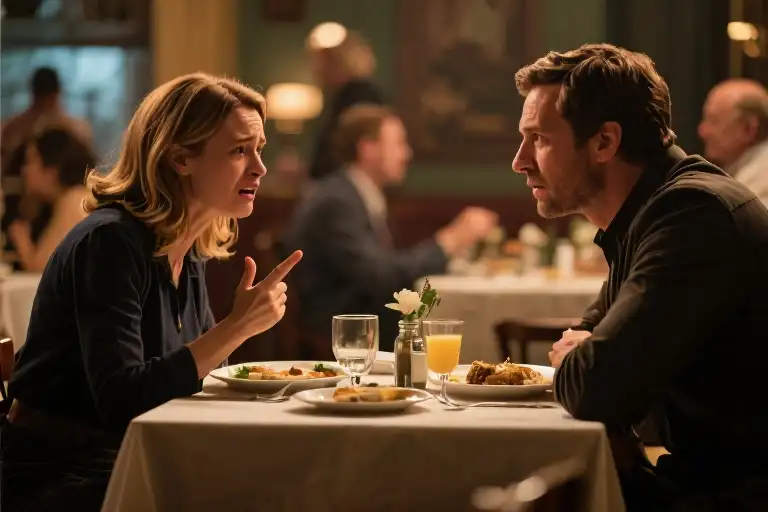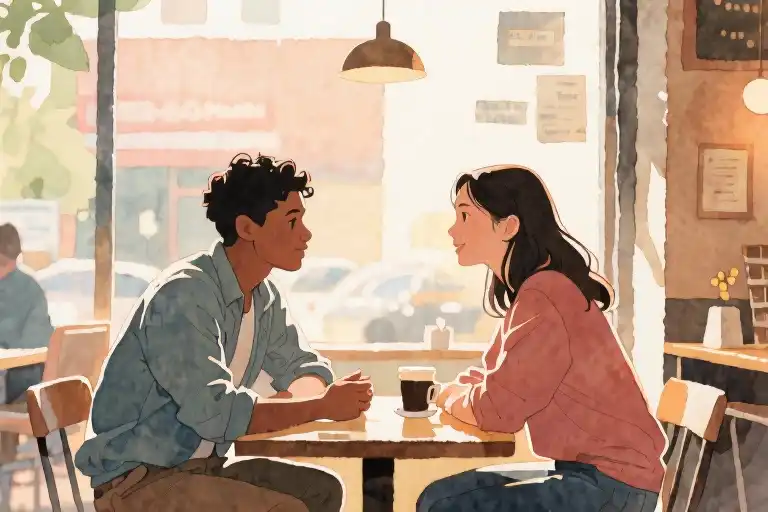At 68, I’m having the best sex of my life—yet for decades, I believed women like me weren’t supposed to want sex. The irony? This sexual awakening came through opening my marriage, an experiment I began not for myself, but to accommodate my husband’s needs. Life has a peculiar way of delivering gifts in unexpected packaging.
Growing up female meant inheriting a legacy of sexual shame so profound I’d blush at my own fantasies. Magazine covers whispered that desire was a privilege reserved for bodies that looked nothing like mine. The streets taught me to armor myself against wandering eyes and unsolicited comments, while at home, the endless calculus of childcare, career, and domestic labor left little energy for intimacy. When my husband reached for me, it often felt like one more demand on an overdrawn account.
For forty years, I accepted this as the natural order of things—until the day we decided to try non-monogamy. What began as a pragmatic solution to mismatched libidos became my unlikely path to sexual liberation. Six months into our polyamory journey, a connection with someone thousands of miles away would unravel everything I thought I knew about pleasure, agency, and what’s possible for women of my generation.
This isn’t just my story. It’s about every woman who’s ever faked an orgasm to end the encounter sooner, every wife who’s scheduled sex like a household chore, every grandmother who’s been told her desires should politely fade away. At an age when society assumes women’s sexuality enters permanent hibernation, I’m discovering capacities for joy I never imagined. The road here was bumpy, surprising, and absolutely worth traveling.
The Invisible Chains: How Society Killed My Desire
The Weight of Shame
Growing up, I learned to treat my sexual thoughts like contraband—dangerous goods that needed to be hidden and suppressed. That first flutter of arousal during a movie scene would immediately trigger panic. “Good girls don’t feel this way” became the silent mantra that shaped decades of self-repression. The messages came from everywhere: Sunday school lessons equating purity with worth, health classes that reduced female anatomy to reproduction charts, and those devastating locker room whispers about “sluts.”
By sixteen, I’d developed an elaborate mental filing system—normal teenage crushes went in the “acceptable” folder, while any fantasy involving my own pleasure got stamped “shameful” and buried deep. This internal policing continued well into adulthood. Even on my wedding night, that critical inner voice hissed: “You shouldn’t enjoy this too much.”
The Beauty Standard Trap
Magazines in the 70s and 80s sold us a brutal lie—that being desirable required looking like someone else entirely. I’d stare at those airbrushed centerfolds, measuring my ordinary body against impossible ideals. The math never worked: my hips were too wide, my breasts too small, my stomach never quite flat enough no matter how many grapefruit diets I tried.
The cruelest trick? These standards kept shifting. When thinness became the ideal, I starved myself. When curves came back in fashion, I felt betrayed. The constant self-scrutiny created a permanent barrier between me and pleasure—how could I possibly relax into my body when I was always mentally editing its flaws?
The Exhaustion Economy
Marriage and motherhood brought different chains. There’s a special fatigue that comes from being everything to everyone—packing lunches at dawn, soothing nightmares at midnight, meeting deadlines in between. By the time we’d tuck the kids in, my husband would reach for me with hopeful hands while I’d lie there calculating: If I say yes now, I can be asleep by 10:30.
Our bed became another chore list. He’d initiate with the confidence of someone who’d never been taught his desires were inconvenient, while I perfected the art of silent accommodation. The unspoken agreement: his needs were urgent, mine were optional. Years of this created a quiet resentment that settled in my bones.
The Public Defense System
Outside our home, I developed survival strategies. Walking to work meant enduring construction workers’ comments, so I learned to stare straight ahead, shoulders tense. Parties required dodging drunk colleagues’ “harmless” touches. Each incident reinforced the lesson: my body wasn’t truly mine—it was public property to be commented on, grabbed at, judged.
The cumulative effect? I stopped inhabiting my body altogether. Sensuality became something that happened to other women—women who weren’t tired, who weren’t ashamed, who hadn’t learned to view their own desires as extravagant luxuries.
Breaking Point
These chains felt inevitable until the day I realized: they weren’t natural laws, just old rules I’d absorbed without questioning. That moment came unexpectedly—not through some grand feminist awakening, but during a particularly exhausting week when my husband complained (again) about our dwindling sex life. As his words hung in the air, something shifted. For the first time, I didn’t feel guilty—I felt angry.
Why was his dissatisfaction the problem to solve? Why had I spent decades twisting myself into pretzels to meet standards I never consented to? That spark of outrage, faint as it was, marked the beginning of my unchaining.
An Open Marriage as a Last Resort
The Unspoken Tension
For thirty-seven years, I measured marital intimacy by the frequency of my husband’s sighs—those wordless expressions of unmet needs that hung heavier than any argument. Our bed had become a negotiation table where his desires carried more voting power, while mine collected dust like unread romance novels on my nightstand. The irony? We’d built this life together, yet somewhere between parenting and menopause, my sexuality had been quietly archived under ‘spousal maintenance.’
The Breaking Point
It happened on a Tuesday. Another perfunctory encounter left me staring at the ceiling, calculating how many more years I could sustain this mechanical dance. ‘I can’t do this anymore,’ I whispered—not to him, but to my reflection in the bathroom mirror at 2 AM. The woman looking back had tears streaming down cheeks that no longer resembled magazine airbrushing, her body bearing the maps of childbirth and survival. That night, I finally named our truth: we weren’t sexually incompatible, we were emotionally exhausted.
The Radical Proposal
Polyamory wasn’t some enlightened choice—it was a Hail Mary pass. When I tentatively suggested opening our marriage over burnt toast one morning, I framed it entirely around his needs: ‘You deserve more passion than I can give.’ The unspoken subtext? Maybe then I could stop feeling like a failed wife. We drafted rules with the solemnity of constitutional lawyers:
- No friends or coworkers (too messy)
- Full transparency (but would we really want it?)
- Protect the primary relationship at all costs (whatever that meant)
First Steps Into the Unknown
Watching my husband prepare for his first date felt like observing a spacewalk—equal parts awe and terror. I distracted myself by alphabetizing spice jars while he nervously adjusted his collar. ‘You’re sure this is okay?’ he asked for the fourteenth time. I nodded, swallowing the lump of ‘what have we done?’ with a sip of oversteeped chamomile. That night, I discovered jealousy has a physical taste: metallic, like biting a foil wrapper.
The Unexpected Calm
Contrary to every Lifetime movie plot, his first encounter didn’t destroy our marriage—it revealed its hidden architecture. With the pressure valve released, we began having conversations that didn’t orbit around sexual frustration. He shared stories about his dates with an enthusiasm I hadn’t heard since our backpacking-through-Europe days. Strangely, I felt… lighter. The rigid roles of ‘deprived husband’ and ‘guilty wife’ were dissolving, making space for something we hadn’t anticipated: honesty.
A Crack in the Foundation
Six months in, during our weekly check-in over chardonnay, he mentioned his new partner loved having her hair pulled. ‘Really?’ I mused, ‘I could never stand that.’ The conversation stalled as we both registered the significance—after four decades together, he was learning more about female desire from someone else. That moment exposed the uncomfortable truth: our marriage had survived on assumptions rather than curiosity.
The Rules Evolve
Our original agreement required constant revisions, like a living document:
- Emotional check-ins replaced rigid schedules
- ‘I statements’ became mandatory (‘I feel scared’ worked better than ‘You’re doing it wrong’)
- Self-discovery time was carved out (I took up salsa dancing; he joined a poetry group)
What began as a sexual pressure-release valve unexpectedly became marital therapy. We weren’t just opening our marriage—we were finally seeing it clearly.
The Accidental Awakening
Six months into our open marriage experiment, something unexpected happened—I received a message from a man living across the country. He was a reader of my stories about non-monogamy, someone who understood the complexities of what we were navigating. Our conversations began casually, exchanging thoughts about polyamory and relationships. Then, gradually, they deepened into something more personal.
What struck me first wasn’t physical attraction (though that came later), but how he listened. For the first time in decades, someone asked me questions like “What do you truly desire?” and waited—really waited—for my answer. There was no assumption, no rushing to the next moment. Just space for me to discover what I might say.
The Mirror of a Stranger
This long-distance connection became an unexpected mirror. Through our talks, I began recognizing patterns I’d accepted as normal:
- How I’d learned to prioritize my husband’s pleasure without questioning my own
- The way I’d internalized that “good wives” shouldn’t need too much
- How menopause had made me assume my sexual story was essentially over
One evening, he asked a simple question that unraveled years of conditioning: “When was the last time you touched yourself just for pleasure, not as part of sex with someone else?” The question stunned me—not because it was provocative, but because I realized I didn’t have an answer.
Firsts at Sixty-Eight
What followed weren’t the explosive revelations you might imagine, but quiet, profound shifts:
- Rediscovering My Body: I began exploring myself without agenda, learning what felt good now that my body had changed post-menopause.
- The Power of Words: We exchanged letters describing fantasies—something I’d never done, even in my youth. Writing them felt transgressive and freeing.
- Virtual Intimacy: Video calls where we talked more than we touched, rebuilding my comfort with being seen—wrinkles, scars, and all.
The greatest surprise? This awakening wasn’t about him. It was about how this connection reflected back parts of myself I’d buried under decades of being a caregiver, a mother, a “good woman.” For the first time, I experienced sexuality that centered my curiosity rather than someone else’s expectations.
The Irony of Liberation
Here’s the beautiful paradox: opening our marriage to address my husband’s needs accidentally gave me space to encounter my own. Where I’d expected jealousy or insecurity, I found an expanding capacity for self-knowledge. Where I’d feared confusion, I discovered clarity.
This chapter of my sexual liberation at 68 isn’t about replacing one relationship with another. It’s about finally meeting myself—not as the young woman shaped by shame, nor the exhausted wife too tired to want, but as someone still capable of discovery, pleasure, and reinvention.
Perhaps that’s the most subversive truth of all: that a woman’s sexuality isn’t a finite resource depleted by age, but a landscape that keeps revealing new territories when given the chance to explore.
A New Map for Women’s Sexuality
For decades, the cultural narrative told us that women’s sexuality fades with menopause. The medical establishment reinforced this myth by pathologizing natural changes, while pop culture either ignored older women’s desires or reduced them to punchlines. But emerging research paints a radically different picture—one that aligns with my own late-life sexual awakening.
The Science We’ve Been Denied
Recent studies reveal what many of us instinctively knew:
- A 2022 Journal of Sexual Medicine study found 68% of women aged 60-75 maintain active sexual interest, though only 43% act on it due to societal barriers
- Neuroscientists confirm sexual pleasure pathways remain intact regardless of age, with some women reporting increased sensitivity post-menopause
- Contrary to stereotypes, emotional intimacy becomes more—not less—important for sexual satisfaction as women mature
These findings expose a cruel paradox: while society assumes older women lose interest in sex, we’re actually facing systemic discouragement. The real “libido killer” isn’t biology—it’s the absence of cultural permission slips.
Rewriting the Rules of Marriage
My polyamorous journey forced me to confront uncomfortable truths about traditional marriage:
- The Monogamy Mirage
The fairy-tale model assumes both partners’ desires will evolve in perfect sync—a statistical improbability over decades. Yet we treat mismatched libidos as personal failures rather than predictable outcomes. - The Generational Divide
My granddaughter’s generation discusses relationship structures with vocabulary we lacked. Terms like “relationship anarchy” and “compersion” create mental frameworks that make alternatives visible. - The Feminist Reckoning
Historically, marriage transferred a woman’s sexual autonomy to her husband. While legally obsolete, these power dynamics linger in subtle expectations about availability and performance.
Creating Your Own Compass
What I wish I’d known earlier:
- Desire is renewable: Like any muscle, sexual energy responds to use and positive reinforcement
- Pleasure is political: Claiming space for older women’s sexuality challenges ageist and sexist norms
- Alternatives exist: From solo exploration to ethical non-monogamy, options abound between celibacy and traditional marriage
At 68, I’ve stopped apologizing for taking up space in the sexual landscape. My body carries decades of stories—not expiration dates. Perhaps the most radical act is simply saying aloud: “I’m here. I feel. I matter.”
The final chapter of women’s sexuality isn’t written by biology or tradition. It’s an open book waiting for our stories.
My Sexuality Isn’t Ending With Age—It’s Just Beginning
At 68, I’ve discovered a profound truth: female sexuality doesn’t expire with menopause. My journey from decades of sexual shame to this late-life awakening has rewritten everything I thought I knew about desire, aging, and women’s liberation.
The Unexpected Gift of Time
Society tells us sexuality belongs to the young—that older women should gracefully fade into celibacy. But my experience proves otherwise. With children grown and societal expectations shed, I’ve found an unprecedented freedom to explore pleasure on my terms. The very years that were supposed to diminish my desire have instead become my most sexually vibrant.
Research supports what my body knows: a 2022 AARP study found 74% of women over 60 consider sexuality important to their quality of life, yet only 43% are sexually active—not from lack of interest, but from lack of opportunity and cultural permission. We’ve been sold a lie that aging and eroticism can’t coexist.
Rewriting the Narrative
This awakening isn’t just personal—it’s political. Every time I claim my right to pleasure at 68, I challenge:
- The medicalization of menopausal bodies
- The invisibility of older women in sexual health discussions
- The assumption that marital sex must follow a predictable decline curve
My open marriage experiment revealed an uncomfortable truth: traditional marriage often extinguishes female desire through unequal labor distribution and obligatory sex. But when we created space for autonomy, something miraculous happened—I remembered who I was before becoming a wife and mother.
An Invitation to Reimagine
To every woman reading this who thinks her sexual story is over, I offer this:
- Desire evolves—what thrilled you at 30 may differ at 60, and that’s growth, not loss
- Communication is ageless—learning to voice needs gets easier with practice
- Freedom comes in many forms—whether through open relationships, solo exploration, or renegotiated monogamy
This isn’t about advocating any particular relationship structure—it’s about rejecting the cultural script that says women’s sexuality has an expiration date. My vibrator sits unapologetically on my nightstand now. I discuss orgasms with my gynecologist. I’ve joined a sexuality discussion group for women over 50.
Perhaps most surprisingly, my marriage has deepened through this process. By releasing each other from being everything to one another, we’ve rediscovered genuine connection. The jealousy we feared gave way to compersion—joy in each other’s happiness.
The Revolution Will Be Pleasured
We stand at a cultural crossroads. As lifespans extend, why shouldn’t our sexual journeys? The old models don’t serve us—not the shame-filled repression of my youth, not the male-centric desire narratives of mainstream media, not the resignation that marriage inevitably kills passion.
So I leave you with this question: What erotic possibilities might emerge if we dared to:
- Challenge the assumption that aging means desexualization?
- Create relationships that adapt to changing needs?
- Celebrate late-life sexual exploration as natural and healthy?
My story isn’t unique—it’s just rarely told. But as more women break this silence, we’re writing a new narrative where sexuality accompanies us through every chapter of life. Not as performance for others, but as celebration of ourselves. At 68, I’m not winding down—I’m just getting started.





